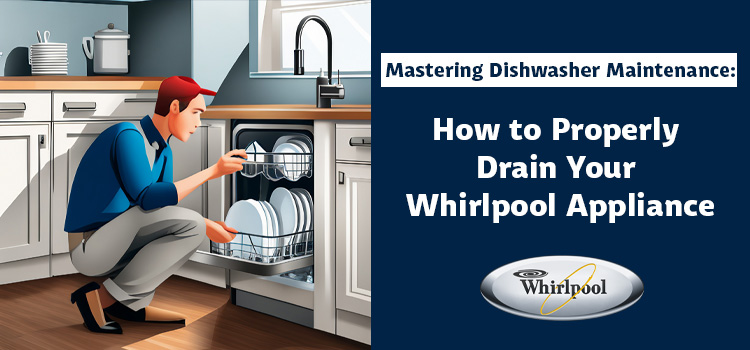As an Amazon Associate, I earn from qualifying purchases
The Ultimate Guide on How to Drain a Dishwasher Whirlpool: Latest Insights 2024

Ensuring your Whirlpool dishwasher drains properly is crucial for maintaining its efficiency and longevity. If you’ve ever found yourself dealing with standing water at the bottom of your appliance, you’re not alone. This guide will walk you through the steps on how to drain a dishwasher Whirlpool, ensuring you can tackle this task with confidence and ease.
Why Proper Drainage Matters
Before delving into the step-by-step process, it’s important to understand why proper drainage matters. A dishwasher that doesn’t drain properly can lead to several issues, including:
- Foul Odors: Standing water can create unpleasant smells.
- Mold Growth: Stagnant water is a breeding ground for mold and bacteria.
- Reduced Performance: Inefficient draining can affect the dishwasher’s cleaning ability.
- Potential Damage: Prolonged drainage issues can lead to damage to the appliance and your kitchen floor.
Tools You’ll Need
To effectively drain your Whirlpool dishwasher, gather the following tools:
- Towels or rags
- A shallow pan or bowl
- A screwdriver (Phillips and flathead)
- Pliers
- A wire hanger or pipe cleaner
Step-by-Step Guide on How to Drain a Dishwasher Whirlpool
Step 1: Safety First
Before starting any maintenance on your dishwasher, ensure the appliance is turned off. Unplug it from the power source or switch off the circuit breaker to avoid any electrical hazards.
Step 2: Remove the Standing Water
Place towels around the base of the dishwasher to soak up any spills. Use a shallow pan or bowl to scoop out any standing water from the bottom of the dishwasher. This will make it easier to access and clean the drain area.
Step 3: Clean the Filter
The filter is often the culprit when it comes to drainage issues. Locate the filter at the bottom of the dishwasher and remove it. Rinse it under running water to remove any debris and food particles. Use a brush if necessary to ensure it’s thoroughly cleaned.
Step 4: Check the Drain Hose
The drain hose is another common area where blockages occur. Locate the drain hose, which is typically connected to the sink’s garbage disposal or the sink itself. Using pliers, disconnect the hose and check for any obstructions. A wire hanger or pipe cleaner can be used to clear any blockages.
For more detailed guidance on setting up your dishwasher, especially in spaces that previously lacked one, you can refer to our comprehensive guide on how to install a dishwasher where there was none.
Step 5: Inspect the Garbage Disposal
If your dishwasher is connected to a garbage disposal, ensure that the disposal is clear of any blockages. Sometimes, food particles can clog the disposal and prevent the dishwasher from draining properly. Run the disposal to clear any debris.
Step 6: Examine the Drain Pump
The drain pump is responsible for expelling water from the dishwasher. If the pump is clogged or malfunctioning, it can hinder proper drainage. To inspect the drain pump, you may need to remove the dishwasher’s lower front panel using a screwdriver.
Once you have access to the drain pump, check for any visible obstructions. If the pump appears damaged or isn’t functioning correctly, it may need to be replaced.
Step 7: Reassemble and Test
After cleaning the filter, drain hose, and inspecting the drain pump, reassemble any parts you removed. Plug the dishwasher back in or turn on the circuit breaker. Run a short cycle to test if the dishwasher is draining properly. If the issue persists, it may be best to contact a professional for further assistance.
Preventative Measures for Future Maintenance
To avoid future drainage issues, consider the following preventative measures:
- Regular Cleaning: Clean the filter and inspect the drain hose regularly.
- Proper Loading: Avoid overloading the dishwasher, as this can impede water flow.
- Rinse Dishes: Rinse off large food particles before loading dishes into the dishwasher.
- Run Hot Water: Run hot water in the sink before starting the dishwasher to ensure efficient operation.
- Use Dishwasher Cleaner: Use a dishwasher cleaner once a month to remove any buildup or residue that may cause drainage issues.
Common Issues and Solutions
Dishwasher Not Draining Despite Cleaning
If your dishwasher still isn’t draining after following the steps above, there may be a more complex issue at play. It could involve the dishwasher’s internal components or plumbing. In such cases, it might be best to consult a professional technician.
Dishwasher Leaking
Leaking can sometimes accompany drainage issues. If you notice water leaking from your dishwasher, it could be due to a faulty door seal or an improperly connected drain hose. For more information on dealing with leaks, you can check our detailed article on what causes a dishwasher to leak out the front.
Conclusion
Knowing how to drain a dishwasher Whirlpool is an essential skill for any homeowner. By following the steps outlined in this guide, you can ensure your dishwasher remains in optimal working condition, providing you with clean dishes and peace of mind.
If you encounter persistent issues, don’t hesitate to seek professional help. Regular maintenance and prompt attention to any drainage problems will extend the lifespan of your dishwasher and enhance its performance.
For additional tips on maintaining your kitchen appliances and ensuring their longevity, feel free to explore our related articles, including how to unlock a GE dishwasher and are Swig cups dishwasher safe.
By staying informed and proactive, you can enjoy the convenience of a well-functioning dishwasher without the hassle of unexpected breakdowns. Happy dishwashing!
As an Amazon Associate, I earn from qualifying purchases
